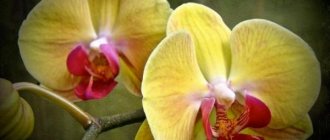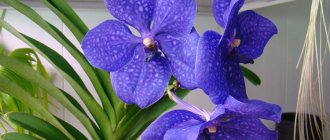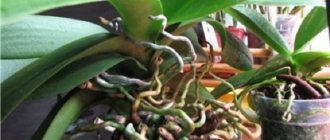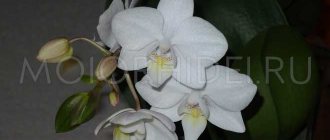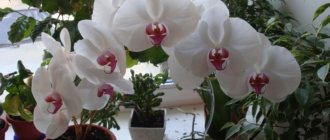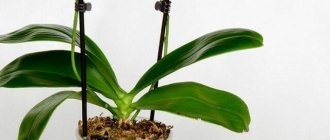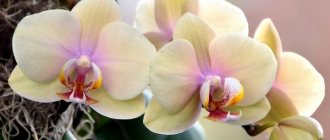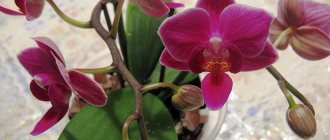Plants » Flowers
0
1009
Article rating
Kira Stoletova
House flowers not only decorate the room, but also serve as an additional source of oxygen. Orchids are popular residents of homes because... It is not difficult to care for them at home. One of their varieties, Phalaenopsis Mix, will delight the owner’s eye for many years.
Phalaenopsis Mix
How to choose Phalaenopsis in the store
You will be amazed at how many Phalaenopsis varieties are on sale, what a variety of bizarre shapes, colors and aromas there are. Choose what you like. It is advisable to choose a butterfly orchid during the flowering period and with a large number of unopened buds. Then there will be a guarantee that you will admire the charming blooms for a long time.
On the specimen you like, pay attention to the leaves - on a healthy flower they should be dark green, fleshy, with a waxy sheen. If the leaves are wilted, slightly wrinkled or have suspicious spots, do not take this specimen, even if the seller sells it at half price. Also inspect the roots carefully. A healthy Phalaenopsis will have powerful, light green rhizomes that sit tightly in the substrate. They may protrude, this is normal. But the roots should not be brown, darkened and drying out. If the plant in the pot is very wobbly, then the root system is not viable at all. Do not buy such copies.
Prices for different varieties of Phalaenopsis vary, from 300 rubles to several thousand. If a plant has a minor defect, and you are offered to buy it at a well-reduced price, evaluate your abilities as a grower. If you have experience in growing orchids, you can buy such a flower. Care and maintenance will help you restore the decorative quality of the flower, and you will definitely wait for it to bloom magnificently.
Orchid blossom
The most important moment in the life cycle of an orchid, which all Phalaenopsis owners look forward to, is the flowering period.
In Phalaenopsis it occurs at different times , with different frequency and duration (depending on the species). But it's always a great spectacle.
Conditions required for Phalaenopsis to bloom
To form flower buds, an orchid requires very little - only careful adherence to all rules and maintenance regimes :
- It is necessary to maintain constant lighting levels throughout the year whenever possible;
- Use lighting in winter;
- Try to create a daily temperature difference.
Even in the absence of any point, the Phalaenopsis orchid will try to bloom at least once a year , because it is not without reason that it is the most unpretentious beauty.
Why doesn't it bloom?
Mistakes made when caring for Phalaenopsis contain the answer to the question: the orchid does not bloom, what should I do? Possible reasons include:
- Lack of lighting;
- Root rotting due to overwatering;
- Lack of daily changes or extreme heat ;
- Stress after transplant;
- Bacterial diseases;
- Excessive fertilizing with nitrogen.
If the last flowering took place more than a year ago , and the plant is not trying to form a peduncle, then all care regimens should be adjusted.
Phalaenopsis has faded, what to do next?
The following tips will help you decide how to care for a faded orchid:
- Do not remove the green peduncle - repeated flowering or formation of baby Phalaenopsis orchids on the peduncle is possible;
- Trim only completely dried arrows at the root;
- Cut the peduncle back to the first living meristem (dormant bud) in hopes of repeat flowering.
But if the plant is weakened, then after the flowers fade, it is advisable to immediately cut off the arrow to give the orchid time to recover.
Description of the flower
Phalaenopsis is an exotic flowering plant of the Orchidaceae family, an epiphyte. Its homeland is the tropical rainforests of Indonesia, Australia, and Southeast Asia. Phalaenopsis has only one growth point - its basal rosette of leaves. The average orchid grows up to one meter. Breeders have developed hybrid varieties to suit every taste - from miniature bushes to giants. The color palette is also amazing: from pure white to almost black colors, as well as pink, yellow, purple, lilac and violet of all shades. In addition to pure tones, there are flowers with speckled petals, with spots, with streaks, and even with hieroglyphs.
Not so long ago, only the most advanced gardeners were engaged in breeding and growing Phalaenopsis, but now these orchids are increasingly found not only in flower greenhouses, where it is easiest to create suitable tropical conditions for them, but also in ordinary apartments of exotic lovers. In this article we will tell you what conditions will be comfortable for a flower if it lives in the same apartment with you.
More detailed information about the plant, as well as a description of Phalaenopsis species and varieties, can be found here .
Caring for a Phalaenopsis orchid at home
Start taking care of the condition of your new pet immediately upon arriving home from the store. The flower does not tolerate a change of residence. If you have chosen a beautiful, strong plant, in which all the roots look strong and healthy, and the peduncle, tall and elastic, is strewn with flowers of extraordinary beauty, then the best thing is to leave the flower alone for a couple of weeks. How to care for Phalaenopsis at this time? No way! At this time, there is no need to water, feed, or replant the Phalaenopsis. There is also no need to place it on the windowsill next to other flowers; let it stand to the side, in partial shade, as if in quarantine. Inspect the flower regularly. If the substrate in the pot consists of large pieces of bark, the roots are gray-green, and the plant looks healthy, then it does not require replanting. Move the pot with the plant to the place of honor prepared for it among other green pets and begin to take care of it according to all the rules.
Replanting Phalaenopsis
Healthy Phalaenopsis bushes are replanted no more than once every two to three years, when its substrate turns into dust. But there are good reasons to replant a plant urgently.
For example, during quarantine, you discovered that the leaves of Phalaenopsis began to wither and sag, and the soil, as it dried out, began to look like a caked sponge. Or if the plant has black spots or other signs of rot on its roots. In both cases, Phalaenopsis should be transplanted into another pot with a new substrate, and without waiting for the end of flowering.
Remove the plant from the planting container and carefully wash its root system under a warm shower. If the soil is poorly washed, leave the orchid in a bowl of water for a while. Then free the roots from the soil and shake off the water. Trim rotten, damaged or overly long roots. Sprinkle the sections with crushed activated charcoal or charcoal. Leave the Phalaenopsis for a while, maybe overnight, in a dry basin, so that all the cuts tighten and dry. The next morning, plant the plant in a new, pre-disinfected pot in a soil mixture suitable for epiphytic plants. Place a layer of the largest pieces of substrate at the bottom of the pot, and use smaller pieces of substrate to fill the voids between the roots to the base of the rosette. Leave two to three cm free at the top of the pot, so that as the aerial roots grow there is a place to add the substrate. A large plant with dense, heavy leaves must be tied to a support and strengthened so that it does not wobble.
If the root system of a flower has been severely damaged, it will be difficult for it to recover. Help the plant. Place the flower and pot in a plastic bag for a couple of weeks to create greenhouse conditions with constant humidity and temperature for the diseased plant. Ventilate it from time to time. First cut the peduncle and place it in a vase with settled water. It is better to sacrifice a peduncle than to lose the entire flower. A cut peduncle with butterfly flowers will serve you as a consolation for a long time.
This may be interesting: Cattleya Orchid - natural varieties and hybrid varieties
Other reasons for transplanting Phalaenopsis into a new pot:
- The landing capacity is too small. This can be determined not only by the roots that stick out above the pot, but by the roots that have filled the entire pot inside and displaced the substrate. The phalaenopsis should be transplanted into a slightly larger pot so that, in addition to the roots, it can contain a sufficient amount of substrate for support. It is better to transplant after flowering.
- if all the leaves fell to one side during transportation, the peduncle with its support is also tilted, healthy roots stick out too much. Transplant the flower into a normal pot with good support, fill the voids with a suitable substrate.
If the orchid feels good, the leaves are elastic, the roots are light green and alive, we do not recommend disturbing the flower. If you want to transplant Phalaenopsis into a new beautiful flowerpot, then it is better to do this in early spring and only after the orchid has finished flowering.
In any case, after each transplant, do not water the plant for the first three to four days; allow the disturbed roots to heal their wounds.
The soil
Phalaenopsis belongs to epiphytic plants. In the wild they grow on trees. Their roots are aerial. They are used not only to strengthen the plant on the bark and branches of trees, but also to feed the plant from the air. The flower also receives moisture and oxygen through its powerful roots. Therefore, Phalaenopsis absolutely do not grow in ordinary garden or forest soil and do not tolerate prolonged flooding. They require a more loose, lightweight, moisture- and breathable substrate. Ready-made soil is suitable for epiphytic or orchid plants. We recommend that you study the composition of the soil. Sometimes it is not suitable for growing Phalaenopsis due to its high moisture holding capacity.
It is not at all difficult to prepare the soil yourself. Collect bark from fallen trees in the pine forest, dense, without resin. Grind it into pieces from 1 to 3 cm, add pieces of charcoal, polystyrene foam, and wine corks of the same size. Stir. Place in a saucepan and simmer for 10 minutes. The composition of the substrate is a little strange, but it will be suitable as a support for the Butterfly Orchid! If the air in the room is dry, you can add a little sphagnum moss to the substrate, just a little, otherwise it will fill the entire space and will not allow the roots to breathe freely. In addition, a large amount of moss will retain moisture, the excess of which can harm the roots. In any case, you should not overfill the pot with substrate, so as not to interfere with air circulation between the roots.
Humidity
Tropical beauty grows better in high ambient humidity. If there is not enough of it, Phalaenopsis may stop growing, its buds will stop opening, and the flowers will begin to dry out. It is necessary to maintain humidity in the room with the flower within 60 - 80%. The minimum permissible humidity is 30-40%. At low humidity and high temperatures, you should place the flower pot in a high tray with wet expanded clay or pebbles. Under no circumstances should the pot stand in water. Water can be poured into wide containers or plates that are placed around the orchid pot. Phalaenopsis loves regular spraying of its leaves and the surrounding air in the morning, especially during those periods of its life when the heating is turned on in houses. By night there should be no water in the leaf axils or at the growing point.
Pot for Phalaenopsis and watering
For this orchid, a not very large translucent plastic pot or similar glass container with holes in the bottom and sides, in which the condition of the substrate and root system will always be under your control, is suitable. The plant needs a pot for support. The pot size should be suitable for the plant's strong root system. In a pot that is too small, the roots will be injured and stick out, while in a pot that is too large, moisture will accumulate and the substrate will not dry out well, which will eventually lead to rotting of the roots.
A translucent pot is perfect
If you don’t really like the picture of intertwined roots in the substrate, you can hide it by placing the pot in a wide multi-colored pot. Drainage holes at the bottom of the pot are required, since water stagnation is not allowed due to the risk of root rotting. A transparent pot is also good because you will constantly watch how the substrate dries out after the next watering. At normal humidity, healthy roots are green; when they dry out, they become lighter. Dry substrate and light roots serve as a signal for the next watering.
If you nevertheless planted Phalaenopsis in a dark pot, you will have to determine the soil moisture at the depth of the pot by touch. Carefully rake the substrate one or two cm deep, try to see if it is damp there. If it's dry, you can water it again. Drain excess water from the pan. Use only settled or boiled water. Previously, they used rainwater, but with the deterioration of the environment in cities, many harmful impurities began to appear in precipitation.
How to water Phalaenopsis:
- in hot weather - every 2-3 days;
- in spring and autumn - once a week;
- in winter - once every two weeks.
If you notice that condensation often collects on the walls of the pot between waterings, then make additional holes in the walls of the pot for better air circulation.
Let's talk about another popular method of watering Phalaenopsis. The pot with the plant is placed for two to three hours in a large container with warm, settled water so that the water covers 1/3 of the pot. This bathing can be replaced by long-term watering - continuously, for 20 minutes, pour warm water into the pot until the substrate in the pot is completely wet and saturated with moisture in the required amount. The orchid's roots will noticeably turn green. After bathing, place the pot in a tray so that excess water comes out through the drainage holes. Excess water must be drained immediately.
If the air temperature in the room remains above 30 degrees for a long time, bathing is carried out once every 5 days.
We draw your attention to the fact that water quality is an important factor in the well-being of Phalaenopsis. If you water it with tap water, even warm, then over time rusty or white spots will appear on the leaves and roots, depending on the excess of salts in the water. It is possible to get rid of plaque using milk or lemon water, which should be used to wash the leaves of the plant. If you use distilled water for irrigation, which contains no salts and trace elements at all, you should add fertilizers for epiphytic plants to such water when watering. It is best to water with filtered or boiled water heated to two to three degrees. above room temperature.
This may be interesting: Cambria Orchid - home care
Sometimes, to grow Phalaenopsis, special epiphytic wicker bamboo or wooden baskets are used, in which the light green roots of the flower with a silver tint develop freely, effectively wrapping around the slats of the basket, both inside and outside it.
But we do not recommend ceramic pots for growing Phalaenopsis. Powerful roots grow into the walls of such a pot and complicate the process of removing the plant from the pot when replanting. Serious damage to the root system of the flower is possible.
Location and lighting
Phalaenopsis love good lighting. The duration of daylight should be at least 12 hours. It is better to place a flower pot on a windowsill in a south-east, east or west direction. It is better not to place it on windowsills facing south - the leaves may get burned. But not far from the southern windows, on a table or hanging shelf, this orchid will grow beautifully. If you only have north-facing windows, only a place directly on the windowsill is suitable for an orchid. © FlowersAdvice.ru
From autumn to spring, the plant will need additional lighting. Don't worry - Phalaenopsis grows well in artificial light. You can use this property when choosing a place in the back of the living room. You just need to keep in mind that over time, Phalaenopsis leans toward the light with its entire body. Therefore, it must be occasionally rotated 180 degrees to prevent it from tipping over or falling out of the pot.
Lighting is especially necessary for a flower when forcing a peduncle and setting buds. At this time, it is advisable to place the pot closer to the light and not disturb it. Do not turn or move from place to place. Leave these manipulations until the last bud opens. Now, during flowering, you can move the pot deeper into the room, into well-lit partial shade.
Temperature
Summer temperature of the flower is allowed from 24 to 30 degrees. In principle, this is the usual room temperature at which we all live in the summer. If the temperature is above 32 degrees for a long time, the flower may lose its buds and flowers, and the leaves will begin to wither. Try to keep the temperature within reasonable limits by spraying the flower and surrounding area, placing the pot in a tray with wet pebbles, and using a split system. To stimulate the formation of flower buds, we recommend keeping night temperatures five to six degrees lower than daytime temperatures.
In winter, the optimal temperature for the growth of Phalaenopsis is 18 - 25 degrees. The plant will withstand a temperature of 10–15 degrees for a couple of days; if longer, it is not a fact that it will not get sick. Under the influence of low temperatures, the roots of Phalaenopsis stop absorbing moisture, and the plant begins to consume nutrients and water previously accumulated in the leaves. The leaves begin to wrinkle and lose their elasticity. Beginning flower growers think that the orchid does not have enough moisture, and they begin to water the plant intensively, which worsens the situation. Frozen roots cannot absorb water and rot. In order to avoid this situation, we recommend keeping a thermometer on the windowsill next to the pot to monitor the temperature. Place the flower pot so that it does not come into contact with the cold glass.
Phalaenopsis love fresh air. Do not forget to regularly ventilate the room, even in winter, while protecting the flower from drafts so as not to provoke any disease.
During the winter dormancy of Phalaenopsis, a couple of weeks after flowering, it is advisable to keep the flower in a cool place, at a temperature of 15 – 17 degrees. Keep in mind - the lower the temperature, the lower the humidity in the room should be, less spraying, less watering. And vice versa. Temperatures below 5 degrees are considered critical for a flower.
How to fertilize a Phalaenopsis orchid
Properly selected fertilizers for the Phalaenopsis orchid are a very important component of its growth and flowering. These orchids obtain all their nutrients from their roots. Therefore, it is worth feeding it with liquid water-soluble fertilizers for orchids. Kemira-Lux fertilizers are suitable in a dose reduced by 2 times. If the plant has few leaves, it needs to be fed with orchid fertilizers, where nitrogen predominates. But don't overdo it! Read the instructions. Otherwise, the growth of green leaves will be to the detriment of the formation of the peduncle. If there are enough leaves, from 4 to 6 in a rosette, but there is still no peduncle, then you should start feeding Phalaenopsis with fertilizers with a high content of phosphorus and potassium, until the beginning of flowering.
In flower shops, before selling Phalaenopsis, they are sometimes fed to stimulate flowering with long-lasting fertilizers in the form of small balls. These balls gradually dissolve in the substrate over time. Keep this in mind when you decide to feed your pet for the first time. First, make sure all store-bought fertilizers are dissolved. It is better to wait and give the plant a break from them for a couple of months.
The flower is usually fed once every two weeks in the summer, and once a month in the winter. There is no need to feed Phalaenopsis during flowering or dormancy!
The use of succinic acid is also very popular. Read more about this in the article: Using succinic acid for orchids.
Phalaenopsis flowering
Many people wonder how to make Phalaenopsis bloom at home? Different varieties of this butterfly orchid bloom at different ages. You need to know the age of your plant. Why isn't your Phalaenopsis orchid blooming? Perhaps because he is still young. If you bought a non-flowering bush, and at home it is clearly not going to please you with a flower shoot, do not get upset ahead of time. Some Phalaenopsis bloom at the age of one and a half years, others - when they are 3 years old. You can determine the age by counting the number of shoots. An adult plant ready for flowering has from 5 to 8 pieces. If there are fewer shoots and the orchid is gaining buds, this is not always good. It happens that a Phalaenopsis orchid that is too young does not have enough strength to recover after flowering, and it may even die. If you have such a case, and a young specimen has thrown away its peduncle, it is better to cut it off.
Different varieties of Phalaenopsis bloom at different times of the year. For some, the peak of flowering occurs at the end of spring - summer, for others - in winter. Some bloom for two months, while others continue to bloom for six months or more. Phalaenopsis flowers are very dense; they stay firmly on the peduncle for a month to two. The flower stalks themselves live much longer. Large-flowered Phalaenopsis bloom almost all year round due to the ability of their peduncles to lengthen, branch and produce new buds during flowering. After flowering, such flower stalks should not be cut off, because they will develop and bloom more than once. In addition, so-called air “babies” often form on them.
This may be interesting: Wanda - caring for a royal orchid at home
An adult plant produces several flower stalks a year - in mid-spring and early autumn. If the butterfly orchid shoots in autumn or winter, you should take care that the flower stalk does not die due to the short daylight hours. We recommend that you purchase a phyto lamp - a special lamp for artificial lighting of plants in the dark season. These lamps provide a lot of light without drying out the air around the flowers. Turn on such lamps when there is a need to extend daylight hours to 10–12 hours.
Another necessary condition for the flowering of some varieties of Phalaenopsis is a difference in day and night temperatures of 5–6 degrees, preferably throughout the year. Creating such conditions can be problematic. From late spring to early autumn, these orchids can be kept outdoors. Then the difference between day and night temperatures is formed naturally. At other times, when Phalaenopsis are indoors, you will have to ventilate the room with the flower well at night, not forgetting that orchids are afraid of drafts.
Rest period
Phalaenopsis has faded, what to do next? After the inflorescences fall, give the Phalaenopsis a little rest. Move the pot to a darker, cooler place. Reduce watering by three times. Do not feed, replant, or spray. Perhaps the old lower leaves will turn yellow and dry out - this is a natural process, do not be alarmed. The peduncle itself, after flowering, may dry out, then prune the orchid. In some varieties of Phalaenopsis, the peduncle remains green. In this case, the following options are possible:
- You can leave the peduncle as is. Then new buds will appear on it over time.
- You can cut the peduncle to the first bud, then over time a new peduncle will grow from this bud.
- You can cut off the peduncle completely and place it in a vase with warm, clean water. Then, over time, he may have a new kidney.
Such a period of rest is simply necessary for an adult plant in order to accumulate more strength for new flowering. In no more than three months, new buds will form on the flower and flowering will begin.
If this does not happen, the Phalaenopsis did not bloom at the right time, we need to find the reason. Read the rules for caring for Phalaenopsis from the beginning, find your mistakes and try to stimulate its flowering in a few months.
Diseases and pests
Disease Control
If not properly cared for, Phalaenopsis Mix may get sick. Among the most popular ailments are:
- Festering. The plant is taken out of the container, the damaged areas are cut off, after which the flower is transplanted into a new pot. Then the orchid is moved to a dark place and not watered for some time.
- The appearance of dark spots. In this case, the Phalaenopsis Mix flower is moved to a cool place.
The appearance of dry leaves is associated with the flower reaching old age. If it is still young, the cause of yellowing is temperature changes or improper moistening of the substrate.
Pest Control
The leaves of the Mix orchid are regularly inspected for the presence of insects. Ways to fight:
- a scale insect invasion is easily recognized by spots on the leaves and deposited larvae - you need to wipe the orchid with a soap solution and remove scale insects (they are mainly hidden in sockets) with cotton swabs;
- when infested by aphids, phalaenopsis leaves are treated with chemical solutions (they can be purchased at any specialized store) every day, while the soil is covered with polyethylene;
- spider mites and worms are eliminated using the drugs “Neoron” and “Fitoverm”.
Prevention
Phalaenopsis Mix requires care according to all the rules, which allows you to avoid problems with its health and attacks from pests. Excessive humidity is just as harmful as its absence. Regular examination of the orchid allows you to identify the disease in its infancy, which increases the chances of recovery.
Cut Phalaenopsis
What could be more beautiful than a bouquet of orchids? Bouquets made from tropical varieties of orchids are presented as rarely as they are treated to real aged French champagne. From the 19th century to the present day, these are the most expensive flowers grown for cutting. Only some types of orchids can stand for many days and even weeks and at the same time maintain freshness and aroma, and Phalaenopsis is one of them.
If you decide to purchase cut Phalaenopsis, pay attention, first of all, to its petals and sepals.
- Flowers with soft, thin, matte petals and sepals tend not to last long.
- Glassiness of the perianth leaves and protruding veins occur in fading flowers.
If the petals and sepals feel strong, and even hard, and look shiny, like wax, then you can buy such a Phalaenopsis; it will last in a vase with water for a long time. And you can still extend his life. Here are some tips:
- If you buy Phalaenopsis in the autumn-winter period, try to carefully pack it to protect it from cold and wind.
- Do not turn the bouquet upside down - the transport liquid will leak out of the capsule.
- If you brought home a bouquet from the cold, do not rush to empty it from the packaging. Let it sit in a warm room for at least an hour. A sudden change in temperature can be more dangerous for a flower than a lack of water.
- Before placing the flower in a vase, use a sharp knife to renew the oblique cut of the stem under running water. This operation must be repeated every two to three days to avoid blockage of the conducting vessels through which water rises to the flowers.
- The water in the vase should be clean and soft. Use boiled, distilled or filtered water at just above room temperature. No preservatives should be added to the water. Moreover, special inscriptions are usually written on the labels of preservatives: “Attention! Not intended for orchids! You don’t have to completely change the water in the vase; just add a fresh portion little by little.
- Keep in mind that cut Phalaenopsis, like potted Phalaenopsis, do not like cold and drafts. Under no circumstances should they be stored in the refrigerator. However, they also do not like bright sun, dry indoor air and heat above 32 degrees.
- Do not place a vase of flowers next to a vase filled with fruit. Ripe fruits emit ethylene gas, which shortens the lifespan of orchid flowers. Wilted flowers also have the property of releasing gas. Therefore, they should be immediately removed from the peduncle and, once fallen, from the table.
Phalaenopsis can be combined with other flowers. For example, it looks great in a bouquet with roses, peony tulips or peonies. Only its stem should be placed in a common vase in a separate container or test tube with distilled water. Then he is not afraid if a preservative is added to the common vase to extend the life of the bouquet. Cut branches of Phalaenopsis are valued and loved for their durability, tenderness and high decorative value. They are so beautiful, colorful and unusual that they are often used in wedding decorations. © FlowersAdvice.ru
